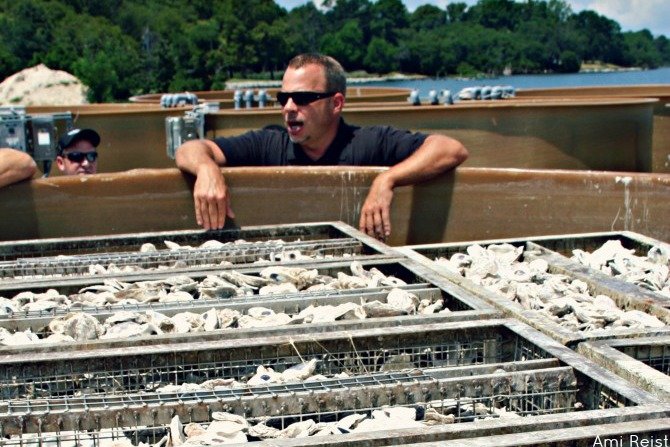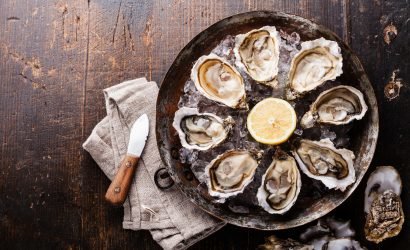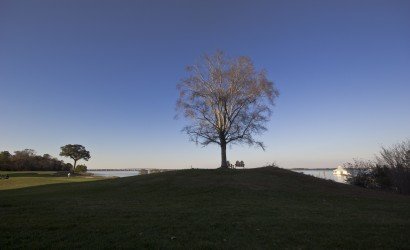On July 31st, 2012, a group of individuals spent the day learning about oyster restoration efforts in Maryland. The oyster restoration supporters took part in a fascinating tour of the Horn Point Laboratory Oyster Hatchery in Cambridge, MD. The tour was guided by a highly educated staff and led by Dr. Don Meritt, Director of the University of Maryland Center for Environmental Studies and Stephan Abel, the Executive Director of the Oyster Recovery Partnership.
Horn Point Laboratory
A Community of Oysters
 |
“In my hand right now, there are 3.75 million oysters,” said Meritt as he held out a ball of brown muck wrapped in a damp coffee filter. He then explained that these oyster larvae will be planted onto recycled oyster shells and distributed at sites throughout the Chesapeake Bay. |
Shell Recycling Alliance
- The Bonfire Restaurant
- Harrison’s Harbor Watch
- Reflections Restaurant
- Embers Restaurant
- Higgins Crab House
- Fager’s Island
- Phillips Crab House
From the Tour
 |
These oysters have been grown in the labratory. They are constatnly monitored and cared for for research purposes. Oyster larvae with ‘eye-spots’ and feet will be seperated from other oysters and introduced into a setting tank. |
 |
Eyed larvae are transferred to the setting tanks where they are attached to shells. After 48 hours, shells are inspected microscopically to see how many larvae are attached. At this point, they are now known as spat. |
 |
Oysters are spawned by scientists in this hatchery lab. After leaving these giant tubs, oyster larvae is place in tanks and fed cultured algae grown in greenhouses. |
 |
Cultured algae is created and monitored closely at the hatchery. The algaewill be fed to the growing oyster larvae. In the algae greenhouse on site there are 18 tanks filled with filtered, sterile seawater. This is where the tiny oysters are fed. |
 |
Algae from local rivers and waterways is recreated in the labratory, then fed to oyster larvae at the hatchery. These brilliant green jars of algae are monitored closely. “These green jars are really high in lipids,” said Meritt. The larvae are fed four times a day. Once larvae has successfully set, ambient water is fed into the tank and the spat begin to feed. Spat are then ready to be deployed to grown outside. |
 |
This is a tank filled with small, one-year-old ‘clutchless oysters. There are roughly 2,500 oysters living in this bin. Clutchless oysters are brittle, hard to shuck, and grown on small particles of shells or nothing at all. They can be raised in trays fills with running water. When introducted into the bay, they are snatched up by fish and crabs immediatly; too small and brittle to make it on their own before being gobbled up. “Blue crabs eat these clutchless oysters like they’re popcorn,” said Meritt. |
 |
Oyster larvae is poured into setting tanks where they will affix to cleaned oyster shell. The resulting spat on shell will be extracted from the tanks and placed on a vessel and planted in pretreated oyster reefs around Maryland’s portion of the Chesapeake Bay. |
 |
Shells of spat sit in these large tubs before being loaded onto a boat. Water in the tubs circulates around the spat for feeding and growth purposes. The shells will soon be loaded onto the “Robert Lee”, a boat used to transport the shells so they can be deposited in the bay. |
 |
Don Meritt has a motto, “More flow, more grow, more dough.” When it comes to oysters, they have to constantly remain in moving water. The moving water offers circulation of food, nutrients, and reproductive materials. If these elements are constantly circulating around an oyster, the creature will take full advantage of it. |
 |
All of the recycled shells used at the hatchery are welcomed at the adequately named – shell pile. All shells are processed and cleaned at this location. They are left to sit in the elements for at least one year before being used in the hatching process. This guarantees that all old, decaying oyster matter has had time to decompose and leave the shell barren. |
 |
Recycled shells are poured into a machine that washes and rinses the material so they can be used as a ‘setting material’ for baby oysters in the future. |
For more information, visit the Oyster Recovery Partnership on the web.
.jpg) |
The Maryland Coastal Bays Program (MCBP) is participating with the Oyster Recovery Partnership and is currently looking for people willing to grow oysters. Unfortunately, you won’t be able to eat these shellfish if you volunteer. You’ll have to give them back to the program. Contact Sandi Smith, MCBP’s Marketing Director, for more information (410-213-BAYS ).
Pictured in front of the oyster shell pile are Bill Mahoney, Sandi Smith, and Davonte Taylor of the Maryland Coastal Bays Program.
|









